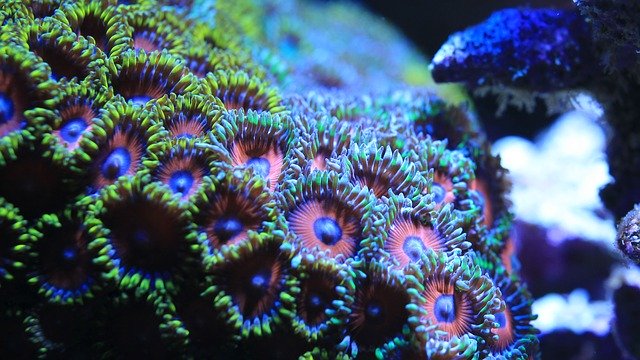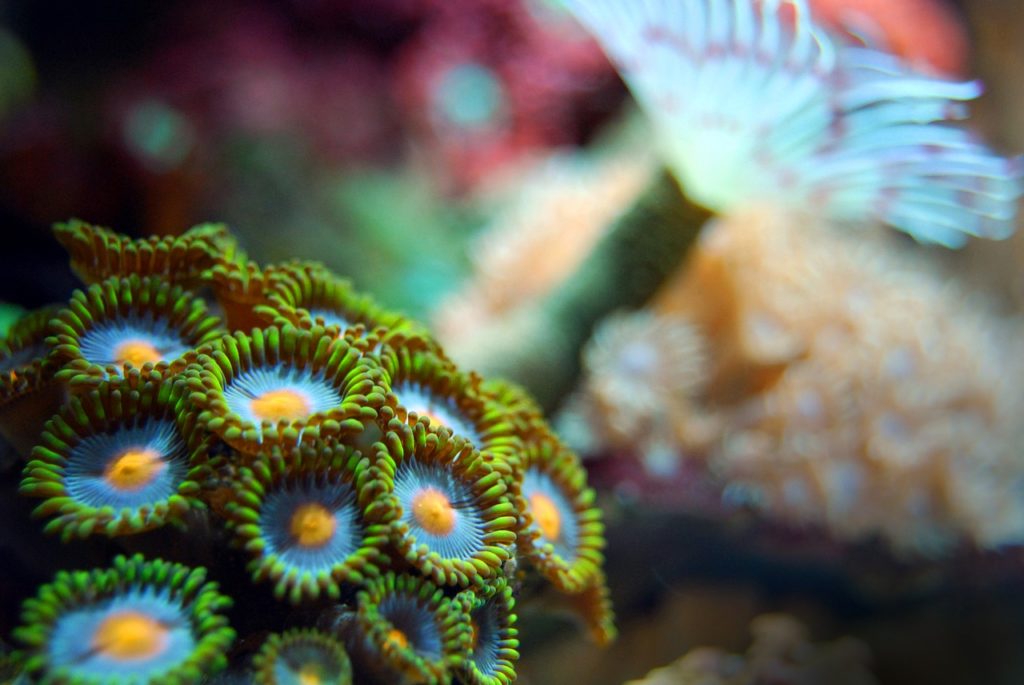
Zoanthid Coral Care

Zoanthids, or commonly known as Zoas, are one of the most popular corals, especially among beginners. It is important to understand Zoanthid coral care in order to get the most out of them.
They are prized for the beautiful colors, ability to grow fast, and their ease of care. There are so many variations, it’s hard not to find a color pattern that you don’t like.
A lot of reefers start out with soft corals, because that is what is recommended a lot, so naturally, beginners drift towards zoas.
Basic Information About Zoas (Zoanthus sp.)
| Care Level | Easy |
| Temperature | 72-78 degrees F |
| dKH | 8-12 |
| Specific Gravity | 1.023-1.025 |
| pH | 8.0-8.4 |
| Lighting | Moderate |
| Flow | Medium |
| Placement | Medium – High |
The Scientific Name for Zoas is Zoanthus sp.
Zoas are colonial type soft corals because they form a colony of individual polyps all living together. They do not have a hard skeleton, but instead have leathery tissue that is comprised of chitin.
Zoanthid Reproduction
Zoas may reproduce both sexually and asexually. They reproduce sexually by producing gametes, and they reproduce asexually by budding, where polyps divide to enlarge the colony. Although, most species reproduce asexually.
What Do Zoas Eat?

It is not really necessary to feed zoanthids, but feeding can help them to grow faster with more vibrant colors. Their main source of food is photosynthesis from your reef lights. To be more exact, they have symbiotic photosynthetic zooxanthellae which supplies the majority of their energy.
They can eat meaty foods like brine shrimp, mysis shrimp, copepods, etc., but we have seen the best results with Reef-Roids from PolypLab. Several feedings a week with this really has helped our Zoas grow fast.
How To Feed Your Zoas And Care For Them
There are several ways to feed your zoas including target feeding and broadcast feeding
- Target feeding: Simply get some thawed mysis shrimp, put some in something like a small turkey baster, and carefully drop over your colony. They will enclose around the shrimp and feed. Our favorite way is to target feed with Reef-Roids.
- Broadcast feeding: This means to simply drop food in several areas of your tank, and let it fall where it does. It is a little harder to do this with meaty foods, therefore a mixed power like Reef-Roids will work very well.
- Poylp Booster can be added to your tank before feeding. This will trigger a feeding response in about 30 seconds.

Where To Place Zoas In Your Tank
Zoas can be placed about anywhere, but overall, they tend to do better in non-direct medium flow with medium lighting. Overall, this is the best coral care you can provide them with lights and flow.
Depending on your tank size, power heads, and lighting equipment, there can be no single answer here. It may help to put your frag in the sand bed to start, and then to slowly move it higher in the tank as long as it responds well. We have always had good results doing it this way.
Zoas do well in the sand bed, on low rock, medium level, and as well as high in the tank. One of the biggest pieces of advice we would give to new reefers to zoa frags is to not keep moving them around all the time. They need a little stability to acclimate, and usually, if left alone, they will do quite well.
It is also worth noting that different types of zoas may respond differently. Mauls may like a different location over Cat Eyes, and Black Orchid zoas may like a completely different location.
We have seen zoa frags that looked fine but had slow growth. But, after moving them to a different location in the tank, they started growing like crazy. It is all about finding that sweet spot for some of them.
If they are unhappy, they will tend to close up and stay closed for extended periods of time. We have had colonies close up for months before.
Flow Requirements For Zoanthids
They do need a little bit of flow, but not so much that causes them to retract off an on due to the pressure. Flow is very important to zoas for many reasons.
Flow allows little bits of food particles to cross over colonies which they will consume. Also, zoas incorporate sand particles into their tissues to help with their structure, so flow will help provide that.
Too little flow for zoanthids can make them more prone to algae issues and other illnesses especially if they are stressed. In addition to all of that, flow needs to be high enough so that detritus does not settle on the colonies.
Best Lighting For Zoas
They will do well in any type of light, whether you are running LED’s, metal halide, or T5’s. LED’s may give you the best color, depending on which types you have. Some of the more beginner ones can be made to look a little more vibrant with violet LED’s and blues.
Zoas tend to do better with a full spectrum of light for photosynthesis, but several reefers have had luck with minimal spectrum, and they have done just fine. We have never tried that though.
If you notice that they are “reaching” and stretching up, they may not be getting enough light, so move them a little bit higher in your tank, or move them to a location that is not as shaded.
If you are running a mixed tank with intense lighting, you may do good to start them low in or near the sand bed. This will get them accustomed to their new location, and if they do well there after a couple of weeks, you can move them up a little bit to a better location.
Zoas can do well in high light, they just need to adjust slowly to it over time, especially if their previous location had lower light intensity.
Best PAR for Zoas
Well, there is not a best PAR for zoanthids because there are so many types. A general recommendation is 80-200 PAR will be good for most of them. Having said that, you can have some sitting at over 800 PAR and thriving. The type of light can also affect this.
Again, 80-200 is a general range. Your frag or colony will let you know if they are happy in their location. If they are closed, not growing new buds, or becoming dull in color, they may need to be moved to a new location. Just remember to not go crazy and move them every other day. They do need time to settle in their new location.
This may take 30 mins. or it may take weeks. Yes, we know that is frustrating.
Summary Of Zoanthid Coral Care

Zoas are great soft corals, and they are extremely popular. The only issue with them is the fact that they are probably the most recommended type of coral for beginners. This means that tons of new reefers with minimal to no experience in reef tanks are trying to learn the ins and outs of saltwater aquariums while maintaining new zoa colonies.
The majority of issues with zoanthids seem to stem from inexperience with the hobby in general. That’s not to say that there are not very experienced people who have had trouble with them. That of course has happened.
Overall, they are a very great choice for new or experienced reefers, and hopefully you were able to learn more about the care for zoas here.
